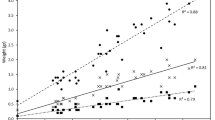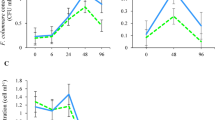Abstract
Aquatic macroaggregates (flocs ≥0.5 mm) provide an important mechanism for vertical flux of nutrients and organic matter in aquatic ecosystems, yet their role in the transport and fate of zoonotic pathogens is largely unknown. Terrestrial pathogens that enter coastal waters through contaminated freshwater runoff may be especially prone to flocculation due to fluid dynamics and electrochemical changes that occur where fresh and marine waters mix. In this study, laboratory experiments were conducted to evaluate whether zoonotic pathogens (Cryptosporidium, Giardia, Salmonella) and a virus surrogate (PP7) are associated with aquatic macroaggregates and whether pathogen aggregation is enhanced in saline waters. Targeted microorganisms showed increased association with macroaggregates in estuarine and marine waters, as compared with an ultrapure water control and natural freshwater. Enrichment factor estimations demonstrated that pathogens are 2–4 orders of magnitude more concentrated in aggregates than in the estuarine and marine water surrounding the aggregates. Pathogen incorporation into aquatic macroaggregates may influence their transmission to susceptible hosts through settling and subsequent accumulation in zones where aggregation is greatest, as well as via enhanced uptake by invertebrates that serve as prey for marine animals or as seafood for humans.


Similar content being viewed by others
References
Dumetre A, Aubert D, Puech PH, Hohweyer J, Azas N, Villena I (2012) Interaction forces drive the environmental transmission of pathogenic protozoa. Appl Environ Microbiol 78:905–912
Fayer R, Dubey JP, Lindsay DS (2004) Zoonotic protozoa: from land to sea. Trends Parasitol 20:531–6
Gebhardt AC, Schoster F, Gaye-Haake B, Beeskow B, Rachold V, Unger D, Ittekkot V (2005) The turbidity maximum zone of the Yenisei River (Siberia) and its impact on organic and inorganic proxies. Estuar Coast Shelf 65:61–73
Giangaspero A, Cirillo R, Lacasella V, Lonigro A, Marangi M, Cavallo P, Berrilli F, Di Cave D, Brandonisio O (2009) Giardia and Cryptosporidium in inflowing water and harvested shellfish in a lagoon in Southern Italy. Parasitol Int 58:12–7
Haile RW, Witte JS, Gold M, Cressey R, McGee C, Millikan RC, Glasser A, Harawa N, Ervin C, Harmon P, Harper J, Dermand J, Alamillo J, Barrett K, Nides M, Wang G (1999) The health effects of swimming in ocean water contaminated by storm drain runoff. Epidemiology 10:355–63
Heinitz ML, Ruble RD, Wagner DE, Tatini SR (2000) Incidence of Salmonella in fish and seafood. J Food Prot 63:579–592
Kach DJ, Ward JE (2008) The role of marine aggregates in the ingestion of picoplankton-size particles by suspension-feeding molluscs. Mar Biol 153:797–805
Kranck K (1984) The role of flocculation in the filtering of particulate matter in estuaries. In: Kennedy VS (ed) The estuary as a filter. Academic Press, Orlando
Leclerc H, Schwartzbrod L, Dei-Cas E (2002) Microbial agents associated with waterborne diseases. Crit Rev Microbiol 28:371–409
Lipp EK, Rose JB (1997) The role of seafood in foodborne diseases in the United States of America. Rev Sci Tech OIE 16:620–640
Lyons MM, Ward JE, Gaff H, Hicks RE, Drake JM, Dobbs FC (2010) Theory of island biogeography on a microscopic scale: organic aggregates as islands for aquatic pathogens. Aquat Microb Ecol 60:1–13
Lyons MM, Ward JE, Smolowitz R, Uhlinger KR, Gast RJ (2005) Lethal marine snow: pathogen of bivalve mollusc concealed in marine aggregates. Limnol Oceanogr 50:1983–1988
Miller WA, Atwill ER, Gardner IA, Miller MA, Fritz HM, Hedrick RP, Melli AC, Barnes NM, Conrad PA (2005) Clams (Corbicula fluminea) as bioindicators of fecal contamination with Cryptosporidium and Giardia spp. in freshwater ecosystems in California. Int J Parasit 35:673–684
Rajal VB, McSwain BS, Thompson DE, Leutenegger CM, Kildare BJ, Wuertz S (2007) Validation of hollow fiber ultrafiltration and real-time PCR using bacteriophage PP7 as surrogate for the quantification of viruses from water samples. Water Res 41:1411–22
Shanks AL, Edmondson EW (1989) Laboratory-made artificial marine snow—a biological model of the real thing. Mar Biol 101:463–470
Shapiro K, Largier J, Mazet JA, Bernt W, Ell JR, Melli AC, Conrad PA (2009) Surface properties of Toxoplasma gondii oocysts and surrogate microspheres. Appl Environ Microbiol 75:1185–91
Shapiro K, Silver MW, Largier J, Conrad PA, Mazet JAK (2012) Association of Toxoplasma gondii oocysts with fresh, estuarine, and marine macroaggregates. Limnol Oceanogr 57:449–456
Siegel S, Castellan NJ (1988) Nonparametric statistics for the behavioral sciences, 2nd edn. McGraw-Hill, New York
Silver MW, Shanks AL, Trent JD (1978) Marine snow—microplankton habitat and source of small-scale patchiness in pelagic populations. Science 201:371–373
Smith WA, Mazet JAK, Hirsh DC (2002) Salmonella in California wildlife species: prevalence in rehabilitation centers and characterization of isolates. J Zoo Wildl Med 33:228–235
Tamburrini A, Pozio E (1999) Long-term survival of Cryptosporidium parvum oocysts in seawater and in experimentally infected mussels (Mytilus galloprovincialis). Int J Parasit 29:711–715
U.S. EPA. (2001) Method 1623: Cryptosporidium and Giardia in water by filtration/IMS/FA EPA-821-R-01-025. Office of Water, U.S. Environmental Protection Agency
Venkateswaran K, Kiiyukia C, Nakanishi K, Nakano H, Matsuda O, Hashimoto H (1990) The role of sinking particles in the overwintering process of Vibrio parahaemolyticus in a marine environment. FEMS Microbiol Ecol 73:159–166
Verney R, Lafite R, Brun-Cottan JC (2009) Flocculation potential of estuarine particles: the importance of environmental factors and of the spatial and seasonal variability of suspended particulate matter. Estuar Coasts 32:678–693
Ward JE, Kach DJ (2009) Marine aggregates facilitate ingestion of nanoparticles by suspension-feeding bivalves. Mar Environ Res 68:137–142
Acknowledgments
We thank Timothy Doane for the water quality analyses; Ann Melli for the protozoal analyses; and Maha Abdulla, Terra Berardi, and Beatriz Aguilar for their assistance with the Salmonella analyses. Stefan Wuertz and Alexander Schriewer provided oversight and advice on quantitative molecular enumeration of the bacteriophage PP7. Andreas Bäumler’s laboratory kindly provided a culture of GFP-labeled Salmonella, and Robert Crawford provided valuable insight on the quantification of this bacterium. Funding for this research was provided by a National Science Foundation Ecology of Infectious Disease grant (Division of Ocean Sciences OCE-1065990) and by fellowship support from the National Oceanic and Atmospheric Administration Oceans and Human Health Initiative (S08-67884).
This publication was prepared by K. Shapiro under NOAA Grant # NA10OAR4170060, California Sea Grant College Program Project # R/CONT-216, through NOAA’S National Sea Grant College Program, U.S. Dept. of Commerce. The statements, findings, conclusions and recommendations are those of the author(s) and do not necessarily reflect the views of the aforementioned organizations.
Author information
Authors and Affiliations
Corresponding author
Electronic supplementary material
Below is the link to the electronic supplementary material.
Table S1
Water quality characteristics of the different water types used in aggregation experiments (DOCX 13 kb)
Rights and permissions
About this article
Cite this article
Shapiro, K., Miller, W.A., Silver, M.W. et al. Research Commentary: Association of Zoonotic Pathogens with Fresh, Estuarine, and Marine Macroaggregates. Microb Ecol 65, 928–933 (2013). https://doi.org/10.1007/s00248-012-0147-2
Received:
Accepted:
Published:
Issue Date:
DOI: https://doi.org/10.1007/s00248-012-0147-2




